Toward the “New Poutès”
On the upper Allier River (Loire tributary), France
The Poutès dam (2015, EDF) and as it will be after the partial removal in 2021 (photo R.Epple)
Abstract : The Poutès dam was built on the Allier for the production of electricity in the middle of World War II and without authorization. Since the end of the 1980s, it has been at the heart of the concerns of environmental NGOs. Indeed, this dam has caused the near disappearance of the great Loire salmon and still remains today a major obstacle to the program for the protection of the species, set up as part of the Plan Loire Grandeur Nature. For over 20 years NGOs, local representatives and EDF (which operates the dam) have been in conflict around this issues, the NGOs asking for it removal. At the end of 2011, a compromise solution emerges, the dam will be maintained but lowered and deeply modified. In March 2015 EDF receives the renewal of the concession (exploitation right) for 50 years with obligations of results for the upstream and downstream migration. The project “New Poutès” is built collectively. Despite major new modifications to the project at the end of 2017, Reconfiguration work on the Poutès dam will begin in 2019 and continue until 2022. In October 2022, the new Poutès dam is inaugurated.
The evolution of the partial removal
New Poutes Optimized : Technical modalities
The dam will be 7m high (17m high and 4m originally planned) for a reservoir of 400m long (3500m currently and 350m initially planned). The sediment transport will be restored by the installation of 2 central sluice gates that will allow the flow of sediment during the morphogenic floods (100m3 / s) but also 91 days / year during the upstream fishmigration (spring and autumn). This crossing device will during these 3 months offer a total transparency for fish. The rest of the time an elevator associated with a fish pass will be functional. The turbine flow will be identical to that of today (28m3 / s, against 20m3 / s in the initial project), with a stop of the production of hydroelectricity during the 3 months of opening of the gates. The downstream migration will be optimized thanks to grids at the level of the finer intake (12 mm instead of 20 mm). More about the New Poutes Optimized.
What are the Milestones ?
In March 2017, 2018, 2019 and 2020 temporary operating measures are implemented to improve downstream salmon migration. The reservoir is lowered by 6 meters (1km length instead of 3,5 km) and an outflow for downstream migration is created. More info http://www.nouveau-poutes.fr/fr/la-vie-du-projet/vie-du-projet/poutes-dam-temporary-operating-measures-downstream-migration-salmon
Preparatory works for reconfiguration of the upstream part of the reservoir (sediment adjustment) were carried out in 2017 (removal of sediments on the banks). More infos
The works will take 3 years and will start in 2019. During spring 2019 the reservoir was completely emptied and the bottom sluice gate wide open. A platform in front of the dam is installed to allow access to the machines on site. The dismantling of the 3 sluice gates (20 tons each) was done in August 2019.
Project follow up
The information and consultation of all partners will continue thanks to the existing environmental monitoring committee which deals with all the concession.
The water regulation monitoring committee will ensure that environmental objectives are taken into account across the entire concession (fish passage upstream and downstream, flow and sediment transit, etc.). This regulation monitoring committee will have all decision-making power to adjust the transparency periods.
The water regulations will be drawn up between September 2019 and the commissioning of the structure in close consultation with the stakeholders. The prescriptions may be revised in the light of studies and the results of the monitoring of the environmental targets for upstream and downstream migration in order to provide corrective measures over the duration of the concession contract. It will be imposed a migration feedback after 8 years, in order to anticipate for 2 years the necessary pre-project studies and thus lead to an effective implementation after 2 years.
A long way to come to this solution
The dam : a major brake to wild salmon reproduction
Built on the Allier River during the Second World War, the Poutès dam did not have authorization for hydropower production. The concession awarded in 1956 ended in December 2007 and the concession holder EDF, received the renewal of the concession in March 2015 for the following 50 years. This only after many years of civil struggle to see this dam completely removed and finally involving only partial removal. This dam is the cause of almost the complete loss of the Loire wild salmon, and is a major barrier for the salmon conservation programme set up by the “Plan Loire Grandeur Nature”.
Since construction in 1941, the dam has been responsible for the loss of 90% of the Loire Allier wild salmon population. “From 1950, the total catch has been only 20% of that compared to the situation before 1941” (Cohendet, 1993). This is because only 8 % of the 2200 hectares of spawning ground used at the beginning of the 19th century are now still reachable.
In 1986 a salmon lift combined with a classic fish pass was installed to allow upstream migration of adult salmon before reproduction. An outflow for downstream smolt (young salmon) migration was also installed. These arrangements are mainly ineffective and technically outdated.
Freeing the Loire Allier for salmon !
The French government is responsible for conservation of the last great migrating salmon population (a threatened species on the world red list of species) in Western Europe. The need to protect this emblematic species has naturally led the state to implement several conservation and restoration programmes during the past 20 years. Tens of millions of Euros have been invested successively in different programmes to sustain the population through restocking; restoration of their habitats and implementation of migration routes.
The most significant actions for the restoration of salmon in the Loire basin are:
- 1994 : Ban on fishing of salmon on the whole Loire Allier basin
- 1998 : Dam removal at Saint-Etienne-du-Vigan (Allier river) and Maisons-Rouges (Vienne river)
- 2001 : Inauguration of the Chanteuges hatchery, the most important in Europe for the repopulation of salmon in rivers.
Despite all these efforts, the great Loire salmon is still on the verge of extinction. Several symposiums have highlighted the Poutès dam is an overriding issue for Atlantic salmon conservation. The removal or reconfiguration of the Poutès dam is the logical follow-on to the huge investment made so far, and without which saving the salmon in a sustained way is not possible.
Remove or reconfigure the Poutès dam?
The turbines at the Monistrol d’Allier hydropower complex are fed both by water collected in the Poutès reservoir (Allier river) and also two other minor dams on the Ance du Sud river (Saint Préjet and Pouzas). These two small dams have little ecological impact, however, the Poutès dam, because it prevents access to the spawning grounds, has a severe impact on the survival of the Loire-Allier salmon.
Because of the impact of the Poutès dam on salmon, both environmental protection groups and fishermen have been asking for the removal of the dam since 1991.
A civil protest against the dam was first established in 1991 and lasted 20 years. The powerhouse in Monistol d’Allier was occupied by SOS Loire Vivante and “Robin des Bois” (Robin Hood) in 1991. In 2004 when EDF applied for renewal of the concession, a national campaign for Poutès removal was organized with support from the WWF and Patagonia.
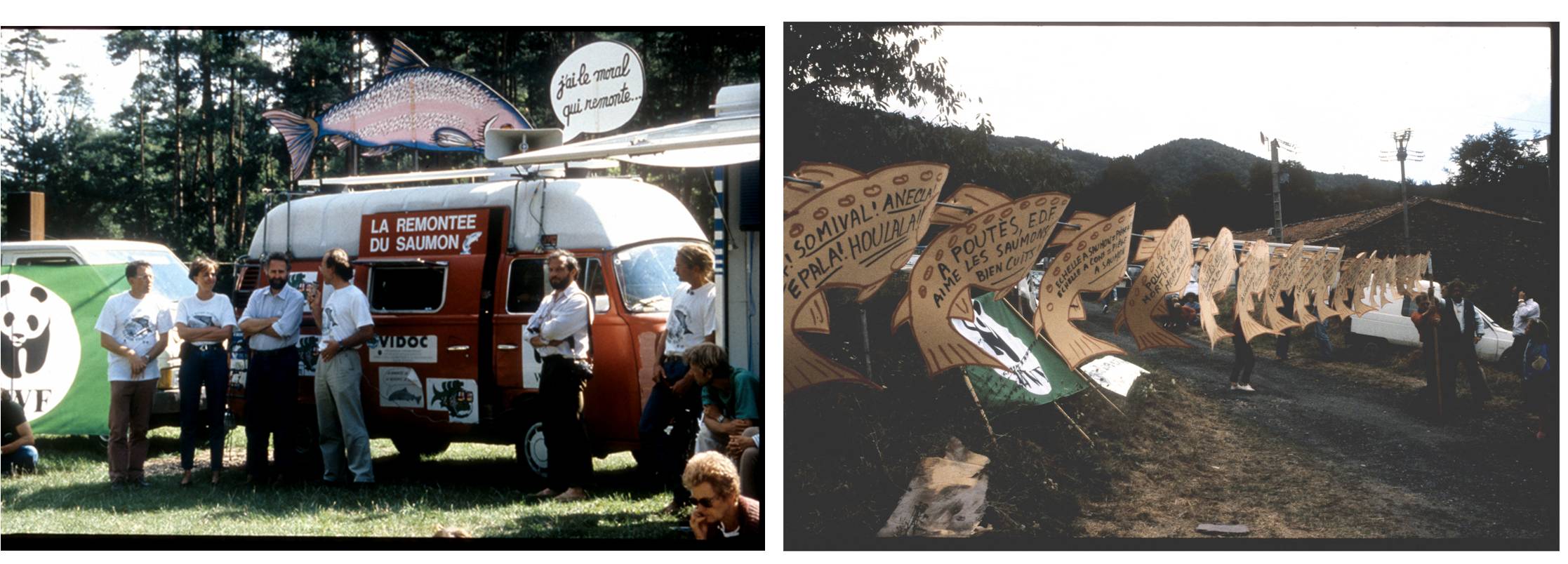
Campaign for the salmon © SOS Loire Vivante
A neutral study ordered by the government showed the negative impact of the Poutès dam on salmon, and recommended to not renew the concession. Nevertheless a public inquiry in 2006 reversed this opinion. At this stage there were three opposing groups: the environmental protection groups, EDF and the elected local officials who wanted to conserve the dam because of local tax income earned by the municipalities. The situation was totally blocked, but bilateral exchanges between EDF and the NGOs resulted in new proposals.
EDF suggested an alternative including complete removal of the dam and a new, movable barrier several hundred meters upstream, which would still allow for 80% to 90% hydropower production. The NGOs have agreed to this solution, but it was rejected by the elected local officials.
In 2011 EDF made a second proposal which was rejected by the NGOs because it did not comply with their specifications. However, a third proposal was successful, and in October of 2011 the French Ministry of the Environment announced the reconfiguration of the Poutès dam. A consensus was finally found (see all the details of the campaign – in French )
The technical project has been drawn up in partnership with all stakeholders: EDF, scientists, the French government, environmental protection groups and elected officials, who have been consulted on each step of the project. A physical model, created in an EDF laboratory has determined the optimal positioning of the various equipment components. “New Poutès” is an innovative project resulting from collective intelligence.
In 2017 a new calendar (6 years instead of 5 years) is presented. But the funds to raise to carry out the modification of the dam are still not there. Nevertheless, work to reconfigure the upstream reservoir begins in June 2017. The water level is lowered by about 8 meters to allow work.
To achieve financial equilibrium, a “New Poutes Optimized” project is being developed (fall 2017). This project takes into account the results of the April 2017 smolt downstream study and studies conducted when reservoir was lowered in June 2017.
see all the details of the campaign – in French
last update : 20/01/2020
Towards the New Poutès!
Localisation
The Poutès dam is located in the Allier river gorge in the Upper Loire, around 70km from the river’s source. Its geographical location makes it the main obstacle for salmon to access their most productive breeding sites, and thus reducing the reproductive potential by 60%.
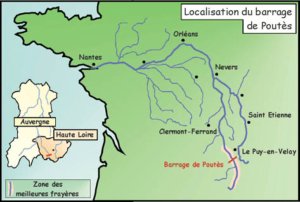
Hydropower Complex Monistrol d’Allier
The Monistrol d’Allier hydropower complex is supplied by water collected in the Poutès reservoir (Allier river) and two other minor dams on the Ance du Sud river (Saint Préjet and Pouzas).
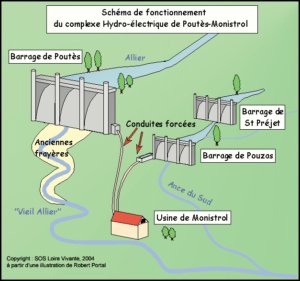
Technical data of the Poutès Dam:
– Height : 17,7 meters
– Width : 85 meters
– Instream flow: 2,5 m3/s since 1992 (previously only 0,5m3/s). Less than half of the reserved flow recommended by the CEMAGREF study.
– Sluice operation
– Bypass river section Vieil Allier) : 10 km
– Maximum turbulent flow: 28 m3/s
– average water volume (Allier at Poutès): 16,9m3/s
– Volume of the reservoir: 2.4 million m3
– Length: 3,5 km
– Surface: 39 ha
Powerhouse at the Monistrol d’Allier
The turbines are fed 55% with water from the Allier (via Poutès dam) and 45% with water from Ance du Sud (2 dams : St Préjet d’Allier and Pouzas)
Production : 82 million kW (this represents 0,0015% of the total French national production)


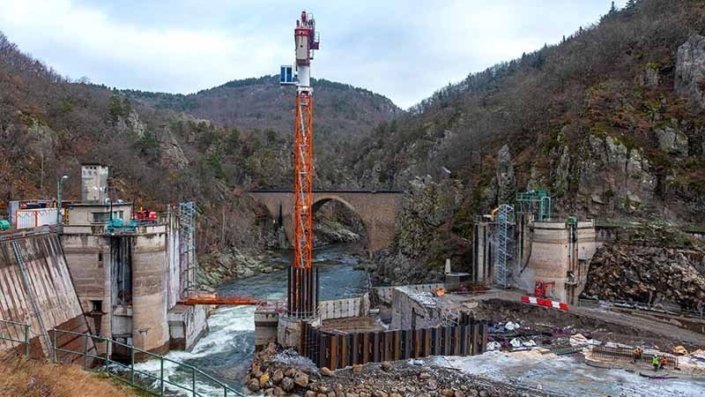
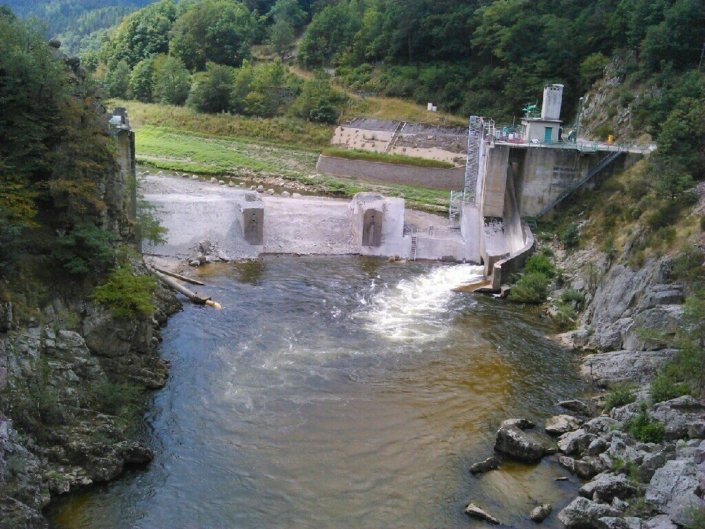
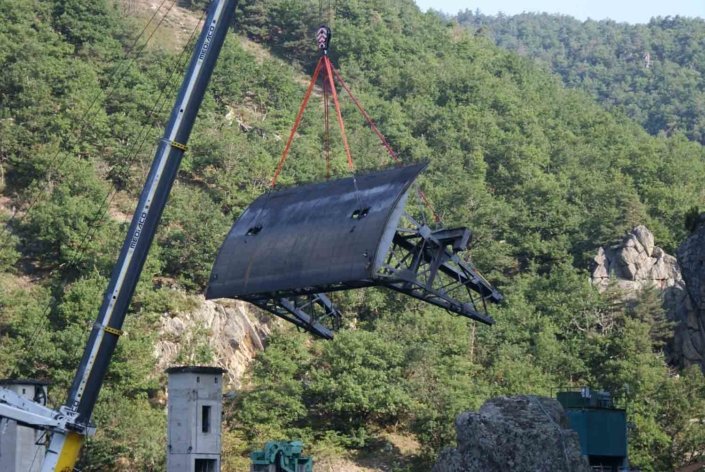
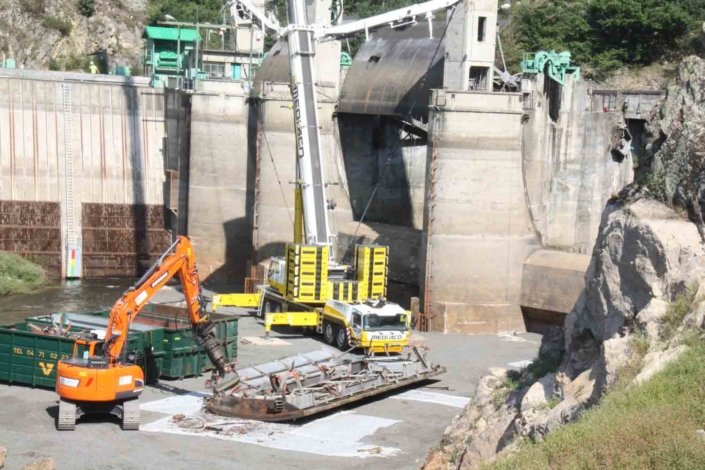
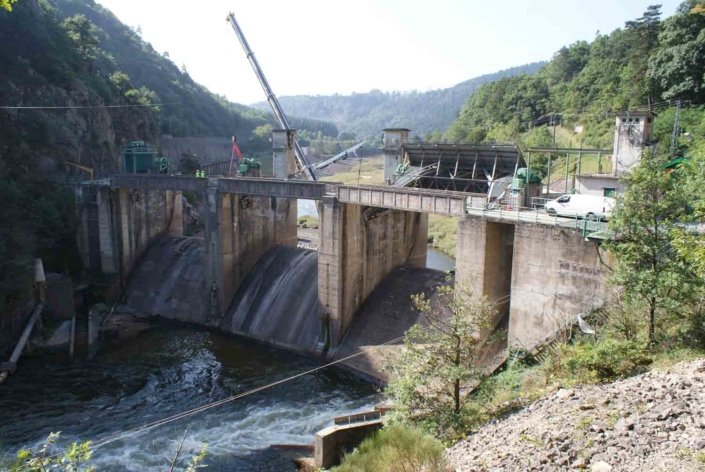




 ERN France
ERN France ERN is the official WWF Freshwater Partner in France and cooperates with WWF Switzerland, Austria, Netherlands and others
ERN is the official WWF Freshwater Partner in France and cooperates with WWF Switzerland, Austria, Netherlands and others